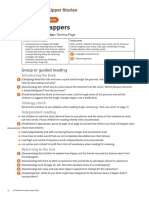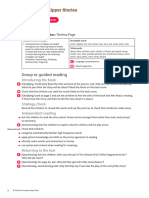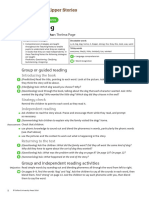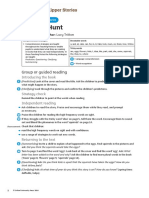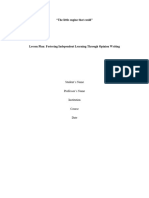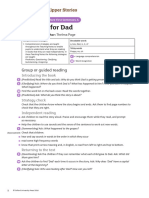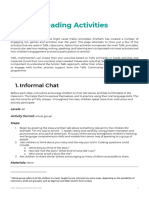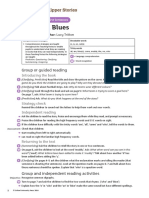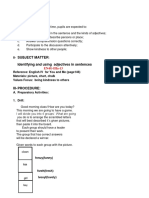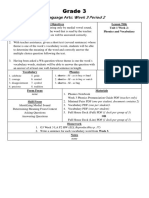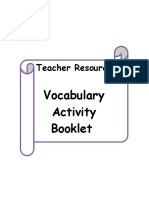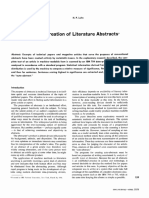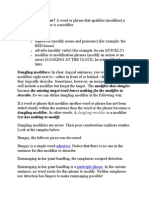Ort BCK Rainbowmach Tns
Ort BCK Rainbowmach Tns
Uploaded by
anil kumarCopyright:
Available Formats
Ort BCK Rainbowmach Tns
Ort BCK Rainbowmach Tns
Uploaded by
anil kumarOriginal Description:
Original Title
Copyright
Available Formats
Share this document
Did you find this document useful?
Is this content inappropriate?
Copyright:
Available Formats
Ort BCK Rainbowmach Tns
Ort BCK Rainbowmach Tns
Uploaded by
anil kumarCopyright:
Available Formats
Oxford Level 8 Stories
The Rainbow Machine
Teaching Notes Author: Thelma Page
Comprehension strategies Tricky words
• Comprehension strategies are taught again, any, because, before, changed, double, field, heavy, move,
throughout the Teaching Notes to enable other, people, ready, straight, though, thought, young, want, where,
pupils to understand what they are reading worked, worry
in books that they can read independently.
In these Teaching Notes the following = Language comprehension
strategies are taught:
Prediction, Questioning, Clarifying, = Word recognition
Summarising, Imagining
Group or guided reading
Introducing the book
• Read the title and look briefly through the pictures to see what happens. Read the blurb on the back
cover together.
(Clarifying) Ask: What is a rainbow? Can you name the colours of the rainbow? Do you think a
rainbow is made by a machine? How is a rainbow made?
(Prediction) Read the blurb on the back cover. Ask: Why do you think Nadim tries to make the
machine work? What kinds of things could go wrong? Why do you think there are colours on the
computer keyboard on the back page?
Strategy check
Check that the children notice punctuation and use it to read with expression when reading aloud.
Independent reading
• Ask the children to read the story aloud. Encourage them to tackle unfamiliar words independently
by using a variety of reading strategies. Praise and encourage fluent and expressive reading when
children read aloud. Praise them for reading silently with concentration.
(Summarising) Ask children to retell the story in just two or three sentences.
Check that children:
• independently and with increasing fluency longer and less familiar texts
• know how to tackle words that are not completely decodable (see the chart above)
• read high and medium frequency words independently and automatically
• use syntax and context to build their store of vocabulary when reading for meaning.
Returning to the text
(Questioning, Clarifying) Ask children to explain why Fred was left alone in charge of the Rainbow
machine. Ask: Why did he move the lorry? How did the lorry get stuck?
(Questioning) Ask: Was it Fred’s fault when things went wrong? Was it Nadim’s fault? Ask the
children to give reasons for their opinions.
1 © Oxford University Press 2014
(Summarising) Ask children to discuss the story with a partner and summarise it in no more than
four sentences.
(Clarifying) Look at page 29, ask: Do you know what bleach is? What does it do? What do people
usually use bleach for?
Group and independent reading activities
Explain their reactions to texts, commenting on important aspects.
(Clarifying, Questioning) Ask children questions about the strange rainbows on pages 20–25: Which
rainbow do you like most? Which rainbow is a clever idea? Can you think of another strange rainbow
they could have had in the story? Ask the children to work in pairs. Ask them to choose the funniest
part of the story and explain to their partner why they think it is so funny.
Can the children explain their choices and reasons easily?
Explore how particular words are used.
(Questioning, Clarifying) Ask children to tell you all the question words they can think of: ‘When’,
‘Where’, ‘Why’, ‘What’, ‘Who’, ‘How’, etc. Reread page 2 and turn the statements into questions,
using the question words in the list, e.g. Where was there a lorry?, Why was it a very big lorry?.
• Ask the children to write some questions, remembering to use question marks. Read all the questions
in turn. Notice that different question words need different kinds of answers. Which question word
asks us to give a reason? Which question word needs a name for an answer? Which question word
asks us to explain something? Which question word asks about the time something happened?
Were the children able to form questions using the most appropriate question word?
Use syntax and context to build their store of vocabulary when reading for meaning.
(Clarifying) Write ‘What a beautiful rainbow!’ on the board. Ask the children to think of some words
they could use instead of ‘beautiful’. Write the new sentences. Ask the children to find ‘Fred turned
pale’ on page 27. Ask the children to think of other ways to say this. Write the new sentences.
Discuss phrases that use colours to express emotions, e.g. ‘He saw red’, ‘She turned green’.
Could the children suggest sentences with similar meanings?
Know how to tackle words that are not completely decodable.
Find ‘straight’ on page 20. Ask the children to explain how they would work out this word if they
did not know it. Find the phonemes that are easy to recognise (s–t–r–ai–t). Ask children to check
the meaning by reading the whole sentence and looking at the illustration. On page 31, find ‘fault’.
Ask the children to suggest ways to read this word. Talk about using the first letter sound and the
sense of the sentence to think of possible words. Prompt them to match their suggested words to
the text and choose the one that makes sense and has the right letter sounds.
Did the children have useful strategies for working out a new word?
Speaking, listening and drama activities
Adopt appropriate roles in small or large groups.
• Nominate a child who reads expressively to be the narrator. Ask other children to take roles as
characters in the story.
• Using pages 12–32, ask the narrator to read the narrative text, or linking sentences, and the characters
to read what they say. Encourage the children to use gestures and movement to re-enact the story.
Can children say each character’s dialogue in the appropriate tone of voice?
2 © Oxford University Press 2014
Writing activities
Draw on knowledge of texts in deciding and planning what and how to write.
(Imagining) Discuss how the rainbow machine went wrong and what was funny in the story. Think of
ideas for other imaginary weather machines. Make a list, then think about how the machines might
work. Ask: How might a snow machine work? Or a mobile freezing unit for ice skating? Or a sunshine
machine for cloudy days?
• Ask the children to describe the kind of machine it is, how it works, what it does and what goes
wrong with it. They will need to decide how it is put right and how the story will end. They could
write a sequence of sentences as a plan first. They will also need to decide upon a title.
• Make time for children to write their stories.
Can children write an imaginative story plan, then write the story?
For teachers
Helping you with free eBooks, inspirational
resources, advice and support
For parents
Helping your child’s learning
with free eBooks, essential
tips and fun activities
www.oxfordowl.co.uk
3 © Oxford University Press 2014
You might also like
- Margolis, E. & Laurence, S. Concepts - Core ReadingsDocument616 pagesMargolis, E. & Laurence, S. Concepts - Core ReadingsOtávio Mattos100% (5)
- Data Mining Project ReportDocument5 pagesData Mining Project Reportkmohanakrishnakumar100% (2)
- ort_bck_kidnappers_tnsDocument3 pagesort_bck_kidnappers_tnsiaz96145No ratings yet
- Ort BCK Brokenroof Tns PDFDocument3 pagesOrt BCK Brokenroof Tns PDFSobia KeswaniNo ratings yet
- Ort BCK Icecream TnsDocument2 pagesOrt BCK Icecream TnsarjunhdgjNo ratings yet
- The Flying Carpet: Group or Guided ReadingDocument3 pagesThe Flying Carpet: Group or Guided ReadingMisbahSakraniNo ratings yet
- Ort BCK Lostkey TnsDocument3 pagesOrt BCK Lostkey Tnsja7025No ratings yet
- Ort BCK Submarine TnsDocument3 pagesOrt BCK Submarine TnsMuhammad Mudassar JavedNo ratings yet
- Ort BCK Redplanet TnsDocument3 pagesOrt BCK Redplanet Tnshashimsaud880No ratings yet
- Ort Bck Daylondon TnsDocument3 pagesOrt Bck Daylondon Tnsafshanaamir103No ratings yet
- Miau222223Document3 pagesMiau222223Tiberiu PopaNo ratings yet
- The Box of Treasure: Group or Guided ReadingDocument3 pagesThe Box of Treasure: Group or Guided ReadingEryNo ratings yet
- ort_bck_play_tnsDocument2 pagesort_bck_play_tnsahmadsubhanidogerNo ratings yet
- Ort BCK Newtrainers TnsDocument2 pagesOrt BCK Newtrainers Tnseyfs.2023No ratings yet
- Ort BCK Stream TnsDocument2 pagesOrt BCK Stream TnsAlmira AslamNo ratings yet
- Ort BCK Laughprincess TnsDocument3 pagesOrt BCK Laughprincess TnsunwantedadvertisementNo ratings yet
- Kipper's LacesDocument2 pagesKipper's LacesThuy NguyenNo ratings yet
- Ort FP Fic Zip TnsDocument5 pagesOrt FP Fic Zip TnsMaha GaberNo ratings yet
- ort_bck_newhouse_tnsDocument2 pagesort_bck_newhouse_tnsahmadsubhanidogerNo ratings yet
- ort_bck_storm_tnsDocument2 pagesort_bck_storm_tnsahmadsubhanidogerNo ratings yet
- Ort BCK Castle TnsDocument2 pagesOrt BCK Castle Tnsgavin.macmillanNo ratings yet
- Ort BCK Dinosaurs TnsDocument3 pagesOrt BCK Dinosaurs TnsAroobaNo ratings yet
- Fun at The BeachDocument2 pagesFun at The BeachThuy NguyenNo ratings yet
- The Dragon DanceDocument2 pagesThe Dragon DanceDobre EsteraNo ratings yet
- The HaircutDocument2 pagesThe HaircutThuy NguyenNo ratings yet
- Ort BCK Goawayfloppy TnsDocument3 pagesOrt BCK Goawayfloppy Tnskda.maryam.javaidNo ratings yet
- A New Dog ORTDocument2 pagesA New Dog ORTeyfs.2023No ratings yet
- Ort BCK Hideseek TnsDocument3 pagesOrt BCK Hideseek TnsMai HamoudaNo ratings yet
- Ort BCK Victorian TnsDocument3 pagesOrt BCK Victorian TnsTalal GhouriNo ratings yet
- Ort BCK Gran TnsDocument2 pagesOrt BCK Gran TnsRice BuoiNo ratings yet
- Spots!Document2 pagesSpots!Thuy NguyenNo ratings yet
- Toads in The RoadDocument5 pagesToads in The RoadThuy NguyenNo ratings yet
- Ort BCK Atschool TnsDocument2 pagesOrt BCK Atschool TnsSophia AdamNo ratings yet
- The Egg Hunt: Group or Guided ReadingDocument3 pagesThe Egg Hunt: Group or Guided ReadingIrsa Shaheen100% (1)
- Ort BCK Secretroom TnsDocument2 pagesOrt BCK Secretroom TnsAbeeha FatimaNo ratings yet
- Ort Ttales Dancprincess TnsDocument4 pagesOrt Ttales Dancprincess Tnsyifan hanNo ratings yet
- Ttops Graphns Goldscarab TnsDocument5 pagesTtops Graphns Goldscarab TnsStanzin NamgailNo ratings yet
- Ort Ttales Beautybeast TnsDocument4 pagesOrt Ttales Beautybeast Tnsyifan hanNo ratings yet
- LGA Tutorial Task EditedDocument14 pagesLGA Tutorial Task EditedRuba Tarshne :)No ratings yet
- ORT Nobody Wanted To PlayDocument3 pagesORT Nobody Wanted To PlayBatool FatimaNo ratings yet
- ShoppingDocument3 pagesShoppingThuy NguyenNo ratings yet
- The LibraryDocument2 pagesThe LibraryThuy NguyenNo ratings yet
- Lesson PlanDocument11 pagesLesson Planobrowser12No ratings yet
- Literature EslDocument31 pagesLiterature EslNiki100% (2)
- Ort BCK Prsntsdad TnsDocument2 pagesOrt BCK Prsntsdad Tnsdamaris.dobreNo ratings yet
- Decode Teaching Notes st5Document12 pagesDecode Teaching Notes st5Jiang TaoNo ratings yet
- Lecture 5 Teaching Speaking Skills at Nursery and Elementary SchoolsDocument8 pagesLecture 5 Teaching Speaking Skills at Nursery and Elementary Schoolsmarivoskanyan63No ratings yet
- Doohickey Teaching NotesDocument3 pagesDoohickey Teaching Notessai charanNo ratings yet
- Lesson Plan: About The BookDocument5 pagesLesson Plan: About The Bookhfc2020No ratings yet
- Tree Town Teachers NotesDocument5 pagesTree Town Teachers NotesLinda WangNo ratings yet
- Ort Ttales Childrenlir TnsDocument4 pagesOrt Ttales Childrenlir Tnsyifan hanNo ratings yet
- ORT Teacher NoteDocument2 pagesORT Teacher NoteSophia AdamNo ratings yet
- 477 Lesson Plan Summer 2013Document12 pages477 Lesson Plan Summer 2013tddhondtNo ratings yet
- Reading ActivitiesDocument9 pagesReading ActivitiesMaftuna BaxronovaNo ratings yet
- The BarbecueDocument2 pagesThe BarbecueThuy NguyenNo ratings yet
- Fly AwayDocument3 pagesFly Awaymickyho569No ratings yet
- How We See Teachers NotesDocument5 pagesHow We See Teachers NotesLinda WangNo ratings yet
- Ort BCK Redsblues TnsDocument2 pagesOrt BCK Redsblues TnsSophia AdamNo ratings yet
- Ela-Grade-2 - Cinderella-1-0-Unit 1Document28 pagesEla-Grade-2 - Cinderella-1-0-Unit 1api-452095852No ratings yet
- Ivy Lesson PlanDocument9 pagesIvy Lesson PlanMelanie Mijares EliasNo ratings yet
- Grade 3: Language ArtsDocument4 pagesGrade 3: Language ArtsjhonathanNo ratings yet
- Ell Lesson PlanDocument5 pagesEll Lesson Planapi-545055000No ratings yet
- Compound WordsDocument11 pagesCompound WordsJuanito BerenguerNo ratings yet
- Symbolism Lesson Plan: Subject: Topic: Grade: Standards: LanguageDocument6 pagesSymbolism Lesson Plan: Subject: Topic: Grade: Standards: Languageapi-331465973No ratings yet
- TRANSLATIONDocument51 pagesTRANSLATIONTesfu HettoNo ratings yet
- What Are Compound WordsDocument7 pagesWhat Are Compound Wordsanalyn lacapNo ratings yet
- Sva in The Orbit of para PDFDocument18 pagesSva in The Orbit of para PDFMadhu KapoorNo ratings yet
- Lexicology ExamDocument3 pagesLexicology ExamНаталия СиакаNo ratings yet
- Iacobini Morphological TypologyDocument5 pagesIacobini Morphological TypologyMbagnick DiopNo ratings yet
- Linguistics StylisticsDocument30 pagesLinguistics StylisticsrashadNo ratings yet
- AFC1-FunctionalEnglish StudytextRevised1 PDFDocument376 pagesAFC1-FunctionalEnglish StudytextRevised1 PDFHafizAhmadNo ratings yet
- Revised Vocab Activity BookDocument20 pagesRevised Vocab Activity BookEya Guerrero CalvaridoNo ratings yet
- Cefr A1Document10 pagesCefr A1BLive - Thalita GuimarãesNo ratings yet
- Phrasal Verbs Defined & Most Common Phrasal Verbs 2Document3 pagesPhrasal Verbs Defined & Most Common Phrasal Verbs 2Menna kouraNo ratings yet
- Luhn 1958Document7 pagesLuhn 1958Muhammad Arsyad VictorNo ratings yet
- G10 Q4 Module 2Document10 pagesG10 Q4 Module 2Roxanne Joy Cuison VentayenNo ratings yet
- StressDocument9 pagesStresssaidatkareem220No ratings yet
- Writing EssayDocument6 pagesWriting EssayAAAANo ratings yet
- Exercises: E e C SDocument6 pagesExercises: E e C SPhương NgânNo ratings yet
- ReadingDocument45 pagesReadingAngel FiloteoNo ratings yet
- Is Bias Inevitable in The Production of Knowledge?Document4 pagesIs Bias Inevitable in The Production of Knowledge?Dhruv JhaNo ratings yet
- 01 Wa6cna Dev Lang Ss 4Document2 pages01 Wa6cna Dev Lang Ss 4HeanTaingOrnNo ratings yet
- Semantics HamawandDocument264 pagesSemantics HamawandSalah Jameel JabraelNo ratings yet
- Light Years Ahead: 3.1 Vocabulary: TechnologyDocument12 pagesLight Years Ahead: 3.1 Vocabulary: TechnologyJaime FalaganNo ratings yet
- PurCom Module 4-6Document13 pagesPurCom Module 4-6JessaMae AlbaracinNo ratings yet
- ENG 101 - Dangling ModifierDocument4 pagesENG 101 - Dangling ModifierSELAHIKHAN0% (1)


